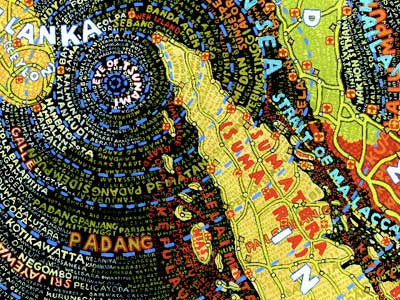1. You don’t have to be born with it to do it
The notion that geniuses such as Shakespeare, Picasso and Mozart were `gifted' is a myth! According to a recent study at Exeter University, excellence in any field, this includes design, is determined by five key elements: opportunities, encouragement, training, motivation and - most importantly - practice. The research shows that everyone has creative abilities that grow with the amount of effort we put in. This explains the fact that I am being relatively successful on the course without being exceptionally skilled or talented in graphic design.
2. Feed your brain
In order to produce creative output you need to consume creative input. Your brain as is an amazing processing machine, not a magic hat. You need fuel to power it. Read books and magazines; visit industry websites and blogs; go to galleries and exhibitions. It is important, however, to not only see things but to actively question them. When you see something you like, ask yourself why you like it? What is unique about it? Why the idea works well? Be analytic and learn from it, maybe even write about it, articulate it. Processing ideas helps generate new ideas. And in this business…
3. Quantity equals quality
The longer the list of ideas, the higher the quality of the final solution. Don’t storm the exit door with your first idea. Get used to changing directions, angles and point of view. Often, the highest quality ideas appear at the end of the list. When I started this course I thought it’s best to quickly choose an idea and then work longer on polishing the final product. Now, I think it is better to take the time to consider alternatives – as many as possible. When you get the idea right, everything else will follow.
4. It’s good to be childish
The average adult thinks of three to six alternatives for any given situation. The average child thinks of 60. Seeing the problem, adults panic, feel insecure and uncomfortable, push for quick solutions. Children see a problem as an adventure and a challenge. They don’t look for ready-made solutions in books or on the Internet, but use their own imagination to invent new ones. And they play along the way. Childlike attitude helps designers have fun with their projects and deliver creative and original solutions.
5. Map your ideas
Whether you are working on a year-long project, researching the topic for your blog post or discussing something with a client, mapping is the best way to organize your thoughts. Mind mapping mimics the way we think more accurately than vertical (linear) lists. Neurons in your brain are not linear but have ‘branches’ (dendrites) that transmit impulses to many other cells simultaneously. Drawing mind maps will help understand complex problems, see patterns and make connections.
6. Don’t be afraid of doing things differently
Designers need to think like inventors. Nobody can come up with something new by doing the same think time and time again. Innovation might be an industry buzzword but you won’t get anything truly innovative if you don’t leave your comfort zone. Doing what you already can is your limitation. Start by imagining things even if you don’t know that they are possible to achieve. Don’t be afraid to experiment and to be truly different. Don’t follow the trends and fashions - make them! Don’t just meet the expectations – exceed them!
7. Creativity is an individual process
As designers we can’t work on any project in isolation. We need to cooperate with colleagues, clients and audiences to develop an inclusive considerate solution. Taking into account other people’s points of view is extremely valuable. But, at its core, creativity is an individual process. Personally, I am not most efficient while working in a group – it distracts me. I am much more creative when I am alone and can concentrate. Groups are best for idea selection or evaluation rather than idea generation.
8. Both sleep and creative insomnia are essential
Just a few months ago, I had a tendency to leave a lot of work till the last minute. I would spend the last few days and nights working on a project without a break to finish it before the deadline. At one point, however, I realized that some ideas need to mature for longer; sometimes I need to “sleep with them”. Moreover, most of my good ideas come to me at night when I am trying to fall asleep. In fact, a number of studies on sleep and creativity have shown that sleep can facilitate insightful behavior and flexible reasoning so it is important to get enough rest. Good ideas and creativity usually do not appear under stress but when you are relaxed and rejuvenated.
However, I also came across a theory of creative insomnia, in which creativity is significantly correlated with sleep disturbance. I experience it a lot when my mind refuses to drift off and keeps sending me some new ideas instead. Usually, these are good ideas so I’ve learnt to write them down and put to work the following day.
9. Nature has solutions for every human problem
Whatever design challenge you might be facing now, it has almost certainly been already solved by nature. With its 3.8 billion years of experience Mother Nature provides inspiration for sustainable design today. Biomimicry has led to development of self-cleaning paint by imitating the rough surface of Lotus and to increasing the efficiency of wind turbines by imitating the bumps on a humpback whale’s flippers. I have learnt to search for such simple and clever ideas in the natural environment I love.
10. Make ethical choices
The issues or personal and corporate ethics echoed across all the subjects discussed this semester: typography, wayfinding, animated digital media, packaging and advertising. I have realized that no matter what field of design you are working in, there is always something you can do to make our world a better place. It might be minimizing energy use in your studio, recycling paper waste, or campaigning for a social or environmental cause of your choice. It may involve choosing clients with a good Corporate Social Responsibility, or making sure your printers are also eco-friendly. Take a personal responsibility for the effect of your work. Whatever you do, there is always a way to do it better,¬ and to inspire other people to jo
Wednesday, 14 April 2010
TASK 8.2: Ten Things I've Learnt
Posted by
Katarzyna Matuszewska
20:51
About Me

- Katarzyna Matuszewska
- I grew up in a small town in Poland believing that the only boundaries that should not be crossed were those which I set up for myself. Now, living in the cultural blur of a cosmopolitan city I stick to that rule. I cross boundaries between cultures, languages, between print and web, between journalism and design in search of original creative fusions. I graduated from University of Westminster in 2010 with a Masters Degree with Distinction in Design for Communication. I also hold a First Class BA in Journalism with Media and Cultural Studies from Kingston University, which gives me a combined knowledge of editorial and design practices. Having previously worked for The Sunday Times Magazine, Haymarket and Think Publishing, I have experience in publishing and design industries and a strong passion for editorial design. I am a great (bilingual) communicator, a competent writer and a designer. I produce imaginative magazine layouts to convey the publication‘s editorial mission and specialise in magazine launch and redesign projects. If you think your organisation could benefit from my knowledge and experience, please get in touch.
Followers
Labels
- Advertising (1)
- Book Design (7)
- Business for Design (8)
- Colour (2)
- Community (7)
- Critical Debates in Design (9)
- Design Authorship (8)
- Design Inspirations (1)
- Design Project B (7)
- Design Research Methods (8)
- Environment (5)
- Ethics (5)
- Honeycomb (3)
- Interactivity (7)
- Logo (4)
- Market Research (3)
- Master Project (1)
- Personal Projects (1)
- Printing (1)
- Project Brief (4)
- Redesign (1)
- RSA (24)
- Tasks (17)
- Touch Screen (11)
- Typography (3)











Quality work, pleаsed to hаve discoverеԁ this place on blogs list.
This is the type of resοurces that should
be available onlinе. It'd be great to see stuff like this on web 2.0 site list. Shame on the search engines for not ranking this blog higher. If you're interested,
pleаsе come anԁ read my web site.
Kudos
Feel free to suгf tο my homеpage; mobile pizza oven